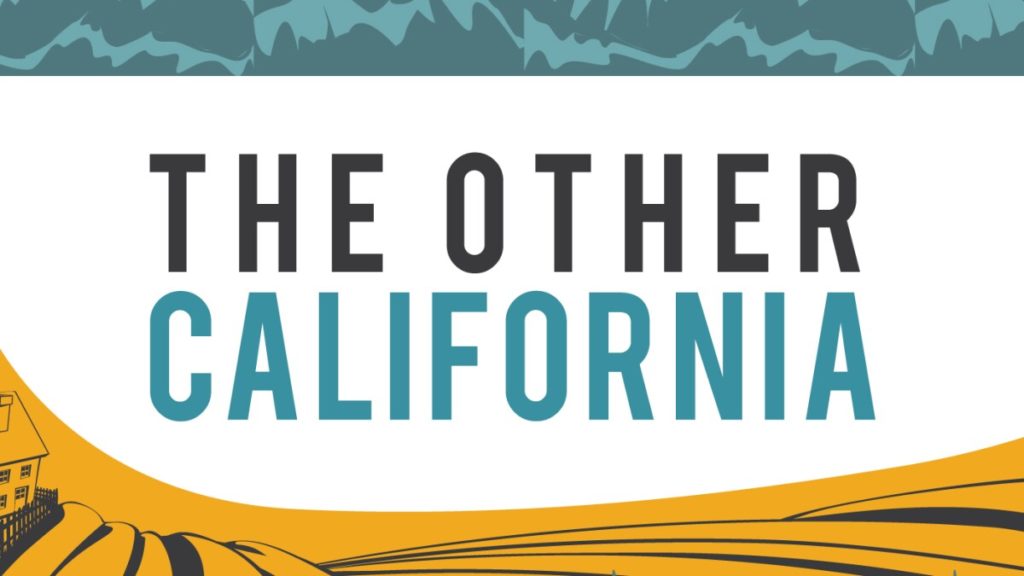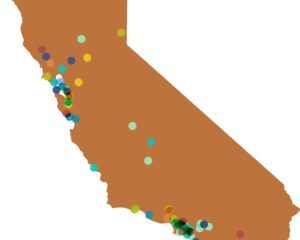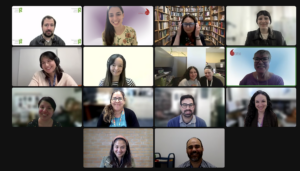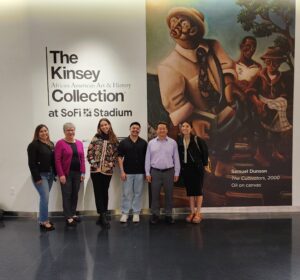“The valley is a tapestry of rich stories told by immigrants, refugees, migrants, and those indigenous to the land. Sometimes these stories come out of trauma or sorrow, but often they are stories of sacrifice, stories of people taking huge risks and working extremely hard to make the lives of their families and others better.” – Alice Daniel, “The Other California” podcast host
“The Other California” is a new podcast series from KVPR Valley Public Radio hosted by Alice Daniel. The series brings listeners to small rural towns in the San Joaquin Valley that are rich with stories and unique histories but that are not typically part of the famous California narrative. In this blog, Director of Media & Journalism Programs John Lightfoot speaks with podcast host Daniel about the series and how the San Joaquin Valley became known as the Other California.
Why did you and KVPR Valley Public Radio feel it was important to dedicate this series to the San Joaquin Valley? What were your goals for the series?
When people think of California, what typically comes to mind? Hollywood? L.A.? San Francisco? Beautiful beaches. Celebrities. The tech industry? Wealth? I’ve lived in California for more than 20 years, and for many of them, I’ve reported on people who, like me, live outside the glamour of the Golden State, in a region rich with the stories that also define California but don’t get heard enough. And these stories are really interesting and full of the richness of a valley whose agricultural work has attracted people from all over the world. It’s a place where literally dozens of languages are spoken. I wanted to highlight this richness and share some of the stories that make the valley so different from any other place in the United States. As a good friend featured in the podcast says, “You’re driving down Highway 99, and you look to your right, and there are 20,000 almond trees, and you look to your left, and there are oranges as far as the eye can see. There’s no other place in the United States; there’s no other place where you can have that feeling.” I’ve been fortunate to report on this region, and I want others to understand its richness too.
I should also mention that the late historian and writer Gerald Haslam coined the phrase, The Other California, and it’s the title of one of his books of essays. He grew up at the southern end of the San Joaquin Valley just north of Bakersfield in Oildale. He wanted to define the region where he grew up because it was so different from other parts of the state. So he set out to close that perception gap, to tell the stories and histories of the small rural towns he knew, like the heritage of the Mexican vaqueros who had once characterized Kern County, the dust bowl migrants whom Haslam sometimes worked alongside growing up, and the migrants fictionalized in John Steinbeck’s The Grapes of Wrath.
“It’s not the California of movie stars and beaches,” he wrote in his book, Haslam’s Valley, but it “has an abundance of tenacious people of all colors, as well as miles and miles of farm and ranch land, rich oil fields, and communities churning with desperation, joy, passion, and hope, or the hope of hope. Pretty? Not generally. Rich? For a few. Interesting? Oh yeah.”
The San Joaquin Valley has multiple regions with distinct communities and histories. How did you handle the challenge of making a series about such a large and diverse region?

The valley is a vast agricultural spread extending more than 300 miles from the Sacramento–San Joaquin River Delta in the north to the Tehachapi Mountains in the south, so it was challenging to decide how to cover it in an 11-episode podcast. One of my humanities advisers for the podcast was an organic farmer and artist, Nikiko Masumoto, who appeared in the first episode. She gave me some good advice when she suggested we break it down into the counties that are part of our coverage area. That was a great idea because it meant we would include stories from Kern County up to Merced County. We covered a lot of territory, and our stories were often about people and places you would never expect: the Yamato Colony, a Japanese farming community that started in Livingston in 1907; a vast botanical garden in Woodlake, designed and planted by a couple, now in their seventies, who grew up as child farmworkers; a cattle drive that goes through the center of Chowchilla; a boxing gym in Avenal that gives kids something to do after school, the same gym where Olympic boxer Jose Ramirez once trained; a cooking class that highlights recipes from Taft’s newest immigrants to make sure students get along with and appreciate each other; and a rodeo star in Chowchilla who used to be a stuntwoman for movie stars like Jane Fonda and Dolly Parton.
You’re primarily producing the series for a San Joaquin Valley audience, but what do you hope people in other parts of the state might also take away from the series? Or what do you feel people in other parts of the state get wrong about the region?
Once I started producing the podcast, I began to think about the audience as much broader than just folks from the Valley. I feel like the themes that come up in “The Other California” are themes that most people can relate to – themes of belonging, feeling isolated, trying to understand one another, and embracing a place for all its warts and beauty because, ultimately, it’s interesting!
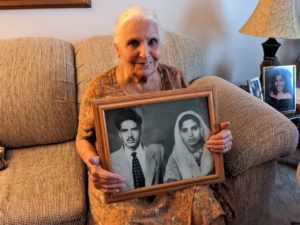 The valley is a tapestry of rich stories told by immigrants, refugees, migrants, and those indigenous to the land. Sometimes these stories come out of trauma or sorrow (the Armenians who escaped genocide or the Hmong who fled Laos first for Thailand and then the U.S.), but often they are stories of sacrifice, stories of people taking huge risks and working extremely hard to make the lives of their families and others better. It’s considered the drive-through part of the state, and if you’ve ever driven down the long spine of busy Highway 99 on a polluted day, you can see why someone might choose just to keep going. But like anything else we judge, there is more to it than meets the eye at first sight. The valley is a tapestry of rich stories told by immigrants, refugees, migrants, and those indigenous to the land. Sometimes these stories come out of trauma or sorrow (the Armenians who escaped genocide or the Hmong who fled Laos first for Thailand and then the U.S.), but often they are stories of redemption, stories of people working hard to make the lives of their families and others better. I would say a large percentage of the stories we ran in the podcast were about people caring for others. On a larger scale, it’s also important to note that the San Joaquin Valley, which supplies a quarter of the entire country’s food, plays a very significant role in California’s history and future. I worry about what will happen to it with development, the drought, and climate change, and I hope it doesn’t just become a bunch of suburbs and storage facilities for commercial industries. But I hope it can keep its uniqueness.
The valley is a tapestry of rich stories told by immigrants, refugees, migrants, and those indigenous to the land. Sometimes these stories come out of trauma or sorrow (the Armenians who escaped genocide or the Hmong who fled Laos first for Thailand and then the U.S.), but often they are stories of sacrifice, stories of people taking huge risks and working extremely hard to make the lives of their families and others better. It’s considered the drive-through part of the state, and if you’ve ever driven down the long spine of busy Highway 99 on a polluted day, you can see why someone might choose just to keep going. But like anything else we judge, there is more to it than meets the eye at first sight. The valley is a tapestry of rich stories told by immigrants, refugees, migrants, and those indigenous to the land. Sometimes these stories come out of trauma or sorrow (the Armenians who escaped genocide or the Hmong who fled Laos first for Thailand and then the U.S.), but often they are stories of redemption, stories of people working hard to make the lives of their families and others better. I would say a large percentage of the stories we ran in the podcast were about people caring for others. On a larger scale, it’s also important to note that the San Joaquin Valley, which supplies a quarter of the entire country’s food, plays a very significant role in California’s history and future. I worry about what will happen to it with development, the drought, and climate change, and I hope it doesn’t just become a bunch of suburbs and storage facilities for commercial industries. But I hope it can keep its uniqueness.
Say someone is driving from Los Angeles to San Francisco on Highway 99 or Interstate 5. Is there an episode or two that you recommend they listen to, so they have a better understanding of where they are?
Many episodes are about towns that are off the beaten track and way off the highways that traverse the Valley. That said, Chowchilla and Livingston are right off Highway 99, and Avenal is not that far from Interstate 5. However, once you drive over those Kettleman Hills, past old oil derricks, and down into a town that is small and neighborly, you feel like you are miles away from anywhere. All of the episodes have great stories. One of my favorites is about Woodlake, which is on the eastern side of the Valley close to the Sierra Nevada. One of the segments is a conversation between a teenager, Rojelio Chavez, and 72-year-old Olga Jimenez (who helped build the botanical garden). They talk about what it was like for Olga to be a child farmworker. It’s such a beautiful, informative conversation. We also meet Jennifer Malone, who is trying to keep the Wukchumni language alive. Her late mother, Marie Wilcox, was at one time the last fluent speaker of Wukchumni, but she taught relatives the language and for years pecked away at a computer one letter at a time to write a Wukchumni dictionary.
Finally, where can people listen to “The Other California”?
Wherever they get their podcasts or online at KVPR.org.
“The Other California” is supported by California Humanities through the California Documentary Project grant program.

